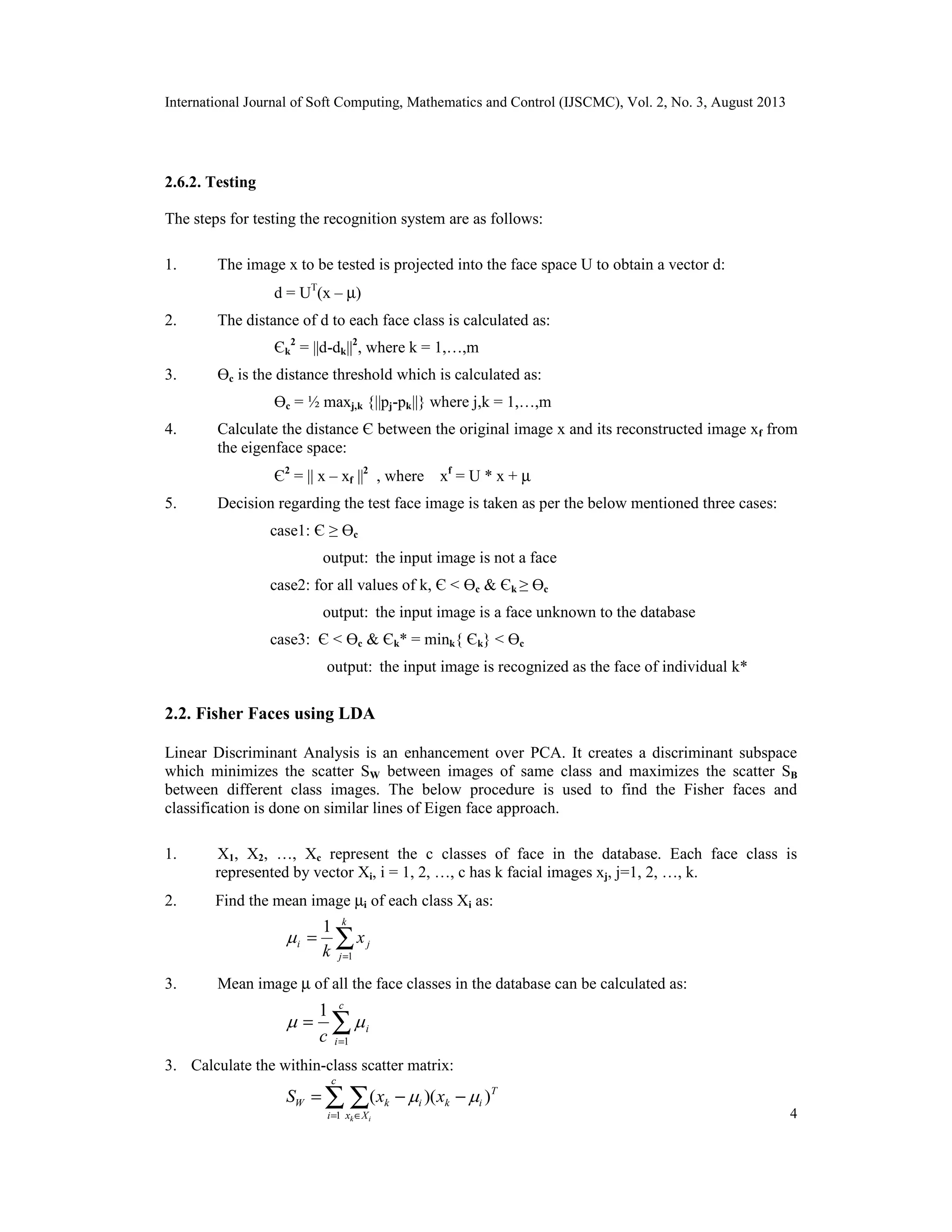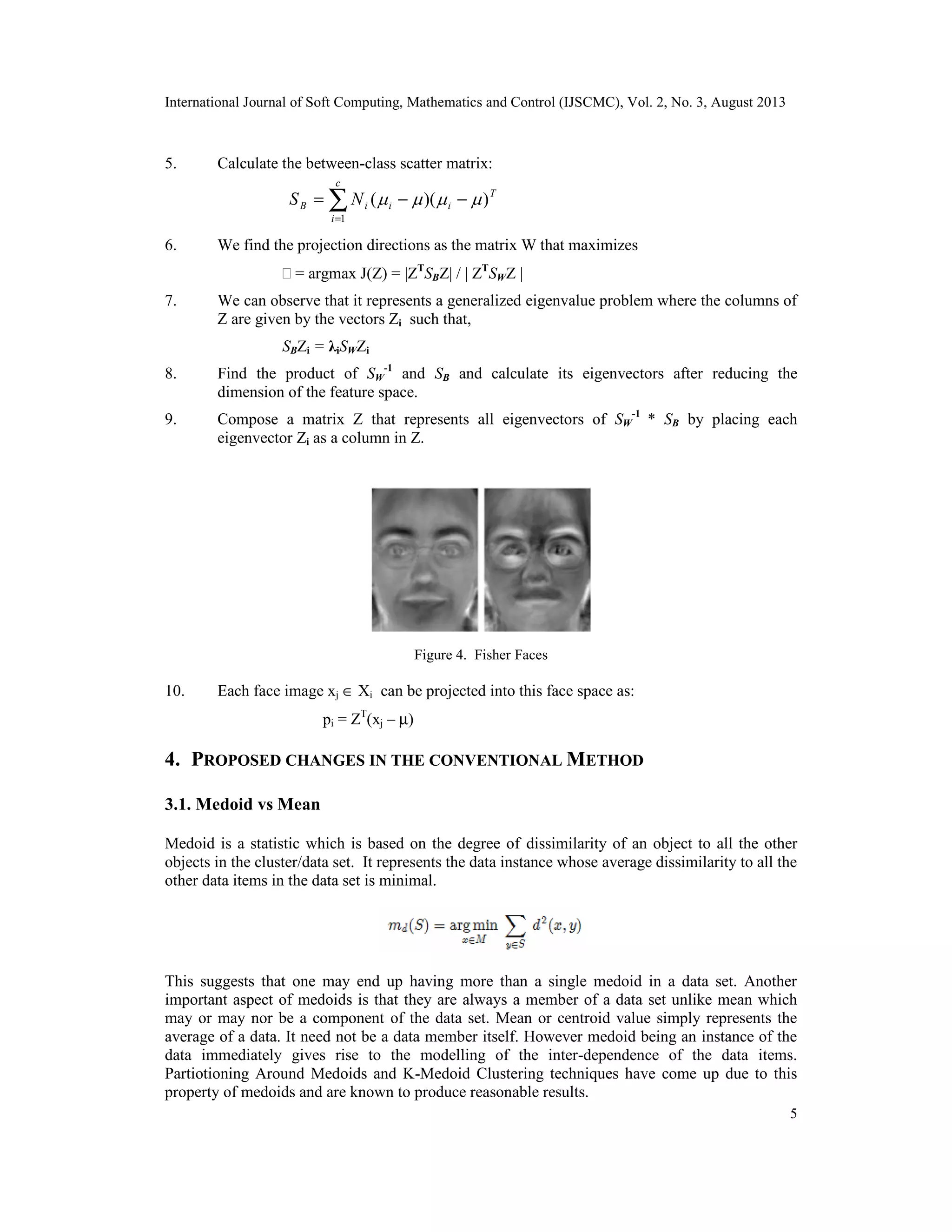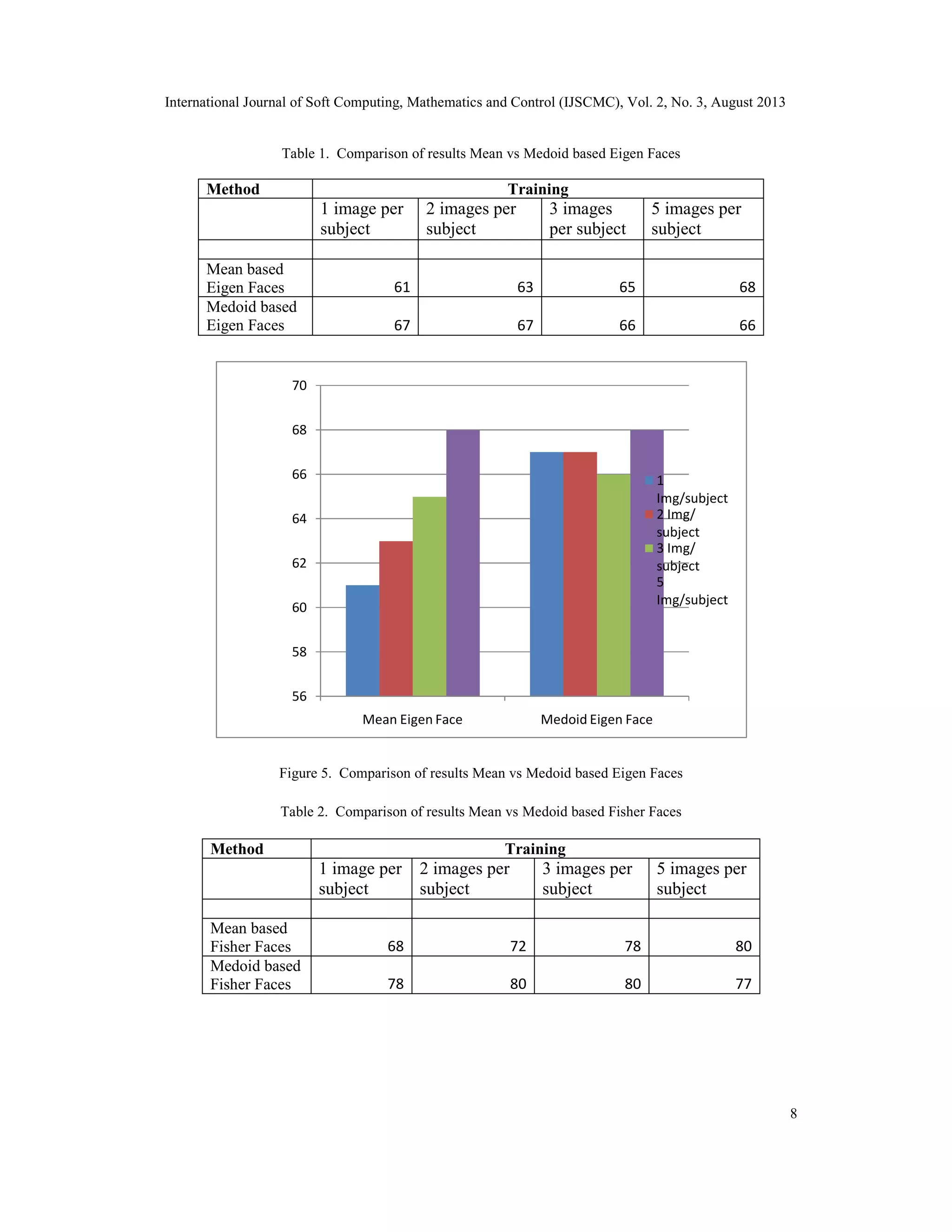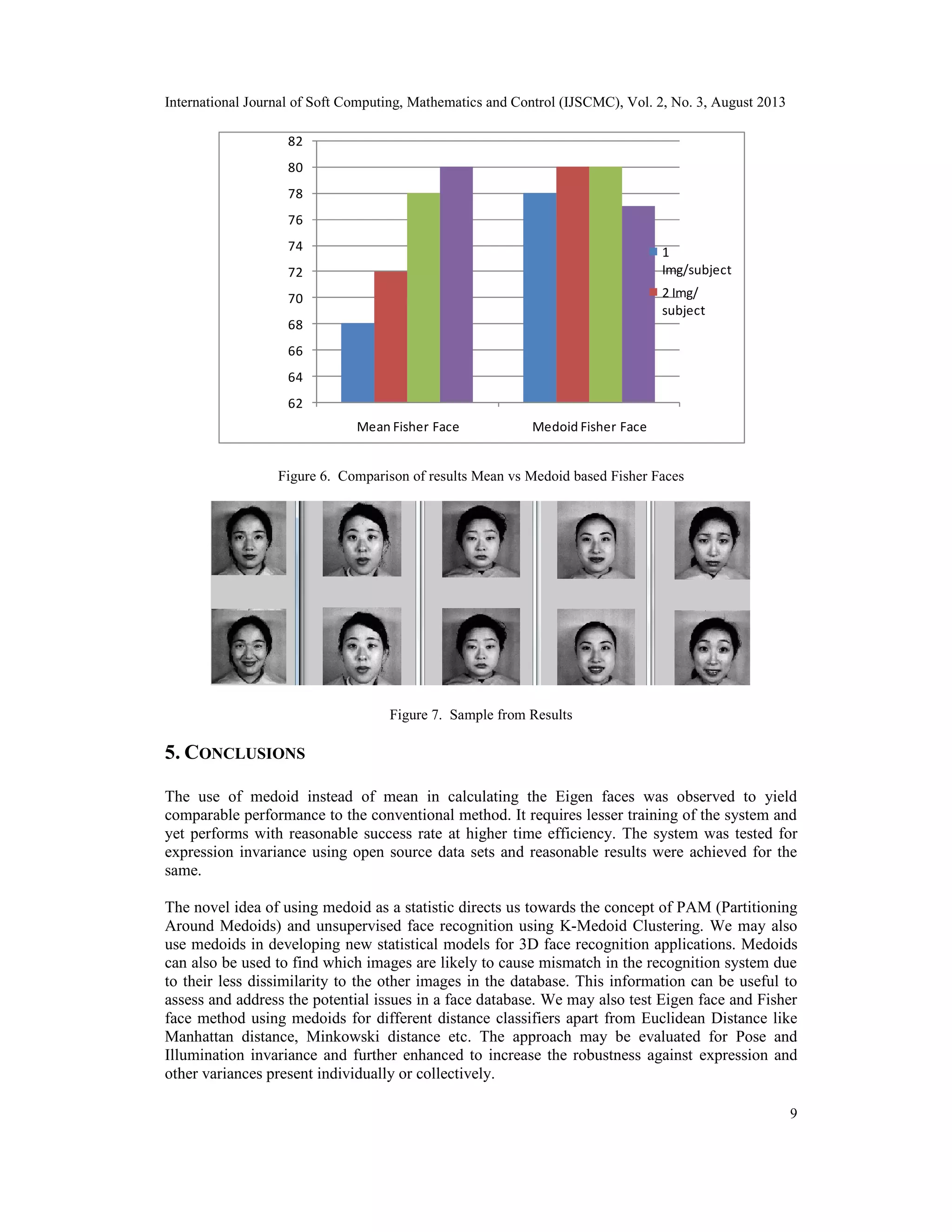This paper presents a new face recognition method that utilizes medoid instead of mean for computing eigen and fisher faces, enhancing performance and efficiency with reduced training requirements. The proposed approach is demonstrated through experiments on the Jaffe database, showing comparable accuracy in recognition across various expressions. The findings suggest that integrating medoid as a statistic can lead to advancements in unsupervised face recognition and 3D applications.
![International Journal of Soft Computing, Mathematics and Control (IJSCMC), Vol. 2, No. 3, August 2013
1
MEDOID BASED MODEL FOR FACE RECOGNITION
USING EIGEN AND FISHER FACES
Aruna Bhat1
1
Department of Electrical Engineering, IIT Delhi, Hauz Khas, New Delhi, India
minu_aru@yahoo.co.in
ABSTRACT
Biometric technologies have gained a remarkable impetus in high security applications. Various biometric
modalities are widely being used these days. The need for unobtrusive biometric recognition can be
fulfilled through Face recognition which is the most natural and non intrusive authentication system.
However the vulnerability to changes owing to variations in face due to various factors like pose,
illumination, ageing, emotions, expressions etc make it necessary to have robust face recognition systems.
Various statistical models have been developed so far with varying degree of accuracy and efficiency. This
paper discusses a new approach to utilize Eigen face and Fisher face methodology by using medoid instead
of mean as a statistic in calculating the Eigen faces and Fisher faces. The method not only requires lesser
training but also demonstrates better time efficiency and performance compared to the conventional
method of using mean.
KEYWORDS
Eigen Face, Fisher Face, PCA, LDA, medoid
1. INTRODUCTION
A biometric system automatically recognizes individuals based on certain physiological or
behavioral traits. Face which is naturally used by humans for recognizing people can be also be
utilized as a biometric trait. In fact it is the most unobtrusive biometric authentication modality
[1]. Humans have the capability of accurately recognizing people using their facial information
both in static and dynamic context. They possess the ability to precisely recognize individuals
even in presence of variations due pose, expression, emotion, illumination, ageing, facial
distraction like hair growth, makeup etc. These observations lead us towards the development of
face recognition systems which could have performance as high as humans deliver [2]. Such a
system needs to be swift and accurate at the same time and possess reasonable resilience too.
Various computational models for face recognition have been designed in the past [3]. Different
approaches have been developed to provide input to the face recognition systems. The entire face
could be used as the input or one may use only the local features like eyes, nose and mouth.
Several techniques for feature extraction have been composed [4] [5]. One of the most significant
achievements in the area of face recognition was the Eigen Face methodology, proposed by
M.A.Turk & A.P.Pentland [6] [7]. It utilizes Principal Component Analysis to extract the features
from the facial images [8]. Utilisation of Karhunen-Lo`eve procedure for the characterization of
human faces was proposed by M. Kirby & L. Sirovich [9]. PCA (Principal Component Analysis)
is a well known technique for performing dimensionality reduction [10]. A D-dimension space is
transformed into C-dimensional space, such that D>C. Through PCA the face image is](https://image.slidesharecdn.com/medoidbasedmodelforfacerecognitionusingeigenandfisherfaces-200424053947/75/Medoid-based-model-for-face-recognition-using-eigen-and-fisher-faces-1-2048.jpg)
![International Journal of Soft Computing, Mathematics and Control (IJSCMC), Vol. 2, No. 3, August 2013
2
transformed into Eigen Face images which contain the principal components of the face image.
The principal components are represented through the eigen vectors. For every facial image, the
eigenvectors with largest eigen values can be used to represent the face.
This methodology was successful in providing a reasonable face recognition system. Many
developments have followed and various alterations to the procedure have been proposed to
further augment the efficiency of the system. One such method was application of Linear
Discriminant Analysis [11] [12] in place of PCA for face recognition. It yielded better results and
was more robust too. The use of FLDA gave rise to the name Fisher faces [12] which are
analogous to eigen faces produced by the PCA method. Many other methodologies on similar
lines have been proposed. Independent Component Analysis [13] and Probabilistic LDA have
also been used for face biometrics and are reasonably efficient. Apart from these one may find
various other approaches which are based on different methods of feature extraction and
classification like using Neural networks [14], SVMs [15], HMM etc. The method discussed in
this paper provides a different approach to calculate the Eigen and Fisher faces. The conventional
statistic of mean has been replaced by Medoid and the method is observed to perform better in
terms of time and efficiency with lesser training effort.
The rest of this paper is organized as follows: Section 2 discusses the details about the Eigen Face
and Fisher Face methods for face recognition. The proposed methodology of using Medoid
instead of mean in the Eigen Face and Fisher Face is discussed in Section 3. It also elaborates on
the concepts of Medoid as a statistic. Experimental results are provided in Section 4. Section 5
discusses the conclusion and future scope.
2. OVERVIEW OF EIGEN FACES AND FISHER FACES METHODOLOGY
Eigen faces are generated using PCA. The technique is capable of identifying a face with
reasonable precision. However its performance is improved by using LDA instead of PCA which
generates Fisher faces that are analogous to Eigen faces generated by PCA method. The
mechanism of both the techniques is detailed below:
2.1. Eigen Faces using PCA
The system follows a supervised learning approach. The system is trained first and then evaluated
for the test data.
2.6.1. Training the system
The steps for training the recognition system are as follows:
1. The input training set consists of n facial images of size M*M.
Figure 1. Sample from Training data](https://image.slidesharecdn.com/medoidbasedmodelforfacerecognitionusingeigenandfisherfaces-200424053947/75/Medoid-based-model-for-face-recognition-using-eigen-and-fisher-faces-2-2048.jpg)
![International Journal of Soft Computing, Mathematics and Control (IJSCMC), Vol. 2, No. 3, August 2013
3
2. The images are represented by vectors of size M2
, x1,x2,x3,…,xm.
3. Find the average image from training set:
µ= (1/m) ∑m
i=1 xi
Figure 2. Mean Image
4. Find the difference of each face differs from the mean image:
ri = xi – µ
5. Derive the covariance matrix:
C = AAT
where A = [r1,…,rm]
6. Derive the eigenvectors for the matrix AT
A of size m x m.
7. If v is a nonzero vector and λ is a number such that Av = λv, then v is said to be an
eigenvector of A with eigenvalue λ.
8. Consider the eigenvectors vi of AT
A:
AT
Avi = µivi
9. Pre-multiplying both sides by A such that,
AAT
(Avi) = µi(Avi)
10. The eigenvectors of covariance matrix are ui = Avi
11. ui represent the Eigen faces.
Figure 3. Eigen Faces
12. A face image can be projected into this face space by:
dk = UT
(xk – µ) where k=1,…,m](https://image.slidesharecdn.com/medoidbasedmodelforfacerecognitionusingeigenandfisherfaces-200424053947/75/Medoid-based-model-for-face-recognition-using-eigen-and-fisher-faces-3-2048.jpg)


![International Journal of Soft Computing, Mathematics and Control (IJSCMC), Vol. 2, No. 3, August 2013
6
3.2. Preprocessing
For analyzing the proposed technique, open source data sources were used. JAFFE database [16]
was used to train and thereafter test the system. The preliminary steps of face detection,
segmentation and facial image processing are crucial to the end results that are obtained by any
face recognition system. The feature extraction using both eigen and fisher faces was preceded by
these vital components of pattern recognition. The images were segmented so that the entire
image consists only of the face of a person. The segmented image containing only the facial
information was converted to grayscale and filtered to remove any noise. Post quality
enhancement of face image, the appropriate ROI for the same was calculated. The facial image is
then ready for feature extraction. Instead of finding the average image, we find the Medoid image
for the training database.
3.3. Feature extraction and Classification
Both the methods of Eigen faces and Fisher faces based on Medoid are explained below:
3.3.1. Eigen Faces using medoids
1. Training the system
a. Convert all the face images (size MxM) present in the training data set to Vectors
of size M2
, x1,x2,x3,…,xm.
b. Find the Medoid image from training set:
Ɣ= argmin ∑i,j d2
(xi,xj)
c. Find the difference of each face differs from the Medoid image:
ri = xi – Ɣ
d. Derive the covariance matrix
C = AAT
where A = [r1,…,rm]
e. Derive the eigenvectors for the matrix AT
A of size m x m.
AT
Avi = Ɣ ivi
f. Pre-multiplying both sides by A such that,
AAT
(Avi) = Ɣi(Avi)
g. The eigenvectors are given by ui = Avi, which represent the Eigen faces.
h. A face image can be projected into this face space by:
dk = UT
(xk – Ɣ) where k=1,…,m
2. Testing the system
a. The test face image x is transformed to vector d:
d = UT
(x – Ɣ)
b. Calculate the Euclidean distance Єk of d to each face class:
c. Өc is the distance threshold which is calculated as:](https://image.slidesharecdn.com/medoidbasedmodelforfacerecognitionusingeigenandfisherfaces-200424053947/75/Medoid-based-model-for-face-recognition-using-eigen-and-fisher-faces-6-2048.jpg)
![International Journal of Soft Computing, Mathematics and Control (IJSCMC), Vol. 2, No. 3, August 2013
7
Өc = ½ maxj,k {||pj-pk||} where j,k = 1,…,m
d. Calculate the distance Є between the original image x and its reconstructed image
xf from the eigenface space:
Є2
= || x – xf ||2
, where xf
= U * x + Ɣ
e. Decision regarding the test face image is taken as per the below mentioned three
cases:
case1: Є ≥ Өc
output: input image is not a face
case2: for all values of k, Є < Өc & Єk ≥ Өc
output: input image is a face unknown to the database
case3: Є < Өc & Єk* = mink{ Єk} < Өc
output: input image is recognized as the face of individual k*
3.3.2. Fisher Faces using medoids
1. The C face classes in the database are represented by vector Xi, i = 1, 2, …, c and each
has k facial images xj, j=1, 2, …, k.
2. Find the Medoid image Ɣ of each class Xi as:
Ɣi = argmin ∑k
i,j d2
(xi,xj)
3. Medoid image Ɣ of all the face classes in the database can be calculated as:
Ɣ= argmin ∑c
i,j d2
(Ɣi, Ɣ j)
4. Calculate the within-class scatter matrix SW and between-class scatter matrix SB using
Medoid values Ɣi and Ɣ.
5. Derive the Fisher faces by composing a matrix Z that represents all eigenvectors of the
product SW
-1
* SB by placing each eigenvector Zi as a column in Z.
6. Each face image xj ∈ Xi can be projected into this face space as:
pi = ZT
(xj – Ɣ)
4. EXPERIMENTAL RESULTS
The method was evaluated using the JAFFE database [16] which contains the facial images with
different expressions (sad, angry, happy etc).](https://image.slidesharecdn.com/medoidbasedmodelforfacerecognitionusingeigenandfisherfaces-200424053947/75/Medoid-based-model-for-face-recognition-using-eigen-and-fisher-faces-7-2048.jpg)


![International Journal of Soft Computing, Mathematics and Control (IJSCMC), Vol. 2, No. 3, August 2013
10
ACKNOWLEDGEMENTS
The author would like to thank the faculty and staff at the Department of Electrical Engineering,
IIT Delhi for the immense guidance and help they have graciously provided.
REFERENCES
[1] R. Baron, (1981) "Mechanisms of Human Facial Recognition," International Journal of Man-Machine
Studies, Vol. 15, pp. 137—178.
[2] R. Chellappa, C. Wilson & S. Sirohey, (1995) “Human and Machine Recognition of Faces: A
Survey,” Proc. IEEE, vol. 83, no. 5, pp. 705-740.
[3] W. Zhao, R. Chellappa, A. Rosenfeld, P.J. Phillips, “Face Recognition: A Literature Survey”.
[4] E.Saber & A.Tekalp, (1998) “Frontal-View Face Detection and Facial Feature Extraction using
Colour, Shape and Symmetry based Cost Functions”, Pattern Recognition Letters, pages 669-680.
[5] R. Brunelli and T. Poggio, (1993) "Face recognition: Features versus templates", IEEE Transactions
on Pattern Analysis and Machine Intelligence, 15:1042-1052.
[6] M.Turk & A.Pentland, (1991) “Eigenfaces for Recognition”, Journal of Cognitive Neuroscience,
vol.3, no.1, pp. 71-86, 1991a.
[7] M. Turk & A. Pentland, (1991) “Face Recognition Using Eigenfaces”, Proc. IEEE Conf. on Computer
Vision and Pattern Recognition, pp. 586-591.
[8] P.J.B. Hancock, A.M. Burton & V. Bruce, (1996) “Face processing: Human perception and principal
components analysis”, Memory and Cognition, 24(1):26-40
[9] M. Kirby & L. Sirovich, (1990) "Application of the Karhunen-Lo`eve procedure for the
characterization of human faces", IEEE Transactions on Pattern Analysis and Machine Intelligence,
12, N1:103-108.
[10] I.T. Jolliffe, (1986) “Principal Component Analysis (Springer-Verlag, New York).
[11] P.N. Belhumeur, J.P. Hespanha & D.J. Kriegman, (July 1997) “Eigenfaces vs. Fisherfaces:
Recognition Using Class-Specific Linear Projection”, PAMI(19), No. 7, pp. 711-720.
[12] W.Zhao, R. Chellappa & A. Krishnaswamy, (1998) “Discriminant Analysis of Principal Components
for face Recognition”, Proc. Third Int’l Conf. Automatic Face and Gesture Recognition, pp. 336-341.
[13] Marian Stewart Bartlelt, Javier R. Movellan & and Ferrence J. Sejnowski, (Nov’2002) “Face
Recognition by Independent Component Analysis”, IEEE Trans. on Neural Networks, vol.13, no. 6.
[14] Henry A. Rowley, Shumeet Baluja & Takeo Kanade , (1998) “Neural Network-Based Face
Detection”. IEEE Trans. on Patt. Analysis and Machine Intelligence, 20(1):23-28.
[15] E. Osuna, R. Freund & F. Girosi, (1997) “Training support vector machines: An application to face
detection”, Proceedings of CVPR'97, Puerto Rico.
[16] Coding Facial Expressions with Gabor Wavelets Michael J. Lyons, Shigeru Akamatsu, Miyuki
Kamachi & Jiro Gyoba Proceedings, Third IEEE International Conference on Automatic Face and
Gesture Recognition, April 14-16 1998, Nara Japan, IEEE Computer Society, pp. 200-205
AUTHORS
The author is a research scholar at Indian Institute of Technology, Delhi.](https://image.slidesharecdn.com/medoidbasedmodelforfacerecognitionusingeigenandfisherfaces-200424053947/75/Medoid-based-model-for-face-recognition-using-eigen-and-fisher-faces-10-2048.jpg)